The University System of Georgia (USG) describes itself as “part of the community” in each of Georgia’s 159 counties. And for good reason. As the largest university system in the Southeast, USG is responsible for 26 higher education institutions ranging from small colleges to research universities. What’s more, the agency oversees nearly 400 libraries and state archive services.
So it’s hardly surprising that USG is also a major part of Georgia’s construction community, charged with managing an annual capital building and renewal program funded via yearly state allotments that recently have averaged $250 million as well as managing major projects funded all or in part by the schools themselves. Project priorities and scheduling are set by USG’s 19-member Board of Regents, which includes two industry members—Tom Bradbury, founder of Smith Douglas Homes, and Richard Evans, founder and chairman of Evans General Contractors, Alpharetta, Ga.
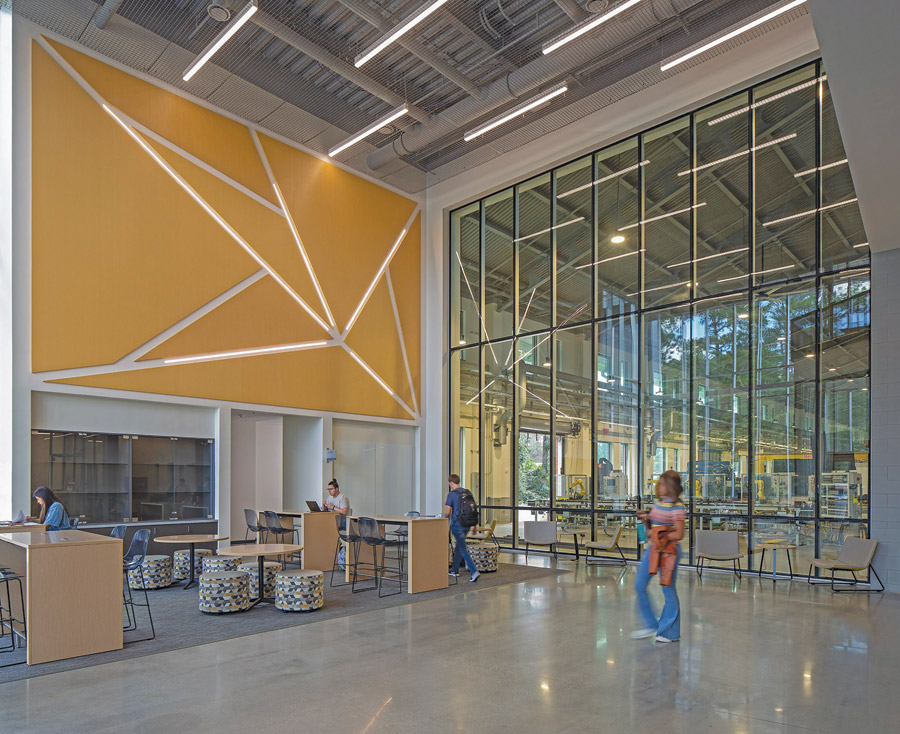
Georgia Southern University’s $60-million Center for Engineering and Research features an open, modern aesthetic.
Image courtesy of the University System of Georgia
USG’s current portfolio of more than 50 active projects totals more than $1.3 billion and ranges from the $63.5-million I-STEM Building 2 at the University of Georgia’s Science Hill to a $5.8-million contract for student support services at Fort Valley State University.
Other recent milestone efforts include a $9.95-million project at Georgia State University to demolish the historic Kell Hall and surrounding plaza to make way for a new central campus greenway and the $88.4-million, 230,000-sq-ft adaptive reuse of Georgia Tech’s Price Gilbert Memorial Library and Crosland Tower.
Given the size and scope of USG’s program, identifying standout projects from one year to the next is not always easy.
“Sometimes a small building for a small campus is more meaningful than something you’d find at a larger research university,” explains Sandra Neuse, USG’s vice chancellor for real estate and facilities. “What’s important is that the project supports each school’s educational mission.”
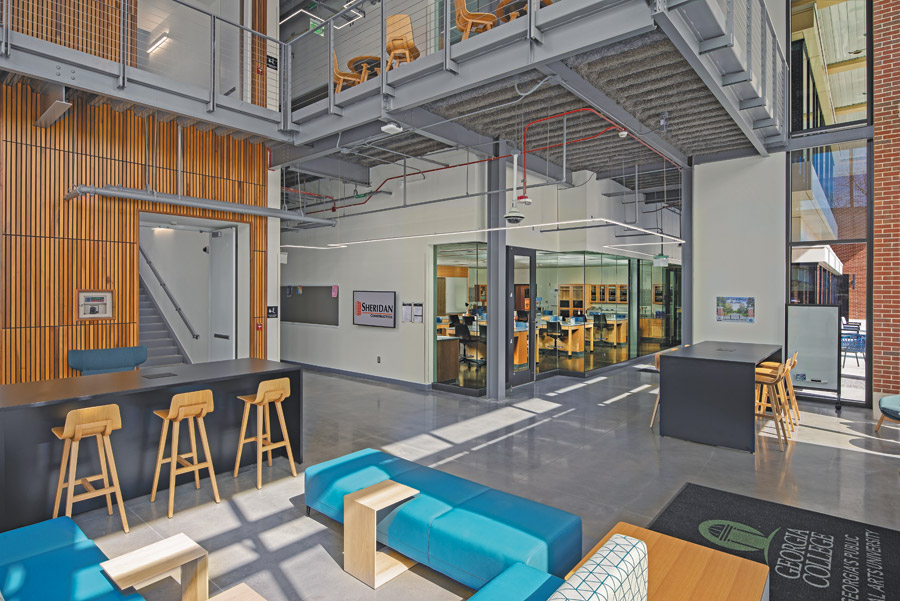
The $22-million Integrated Science Complex, designed by Cooper Carry, is the latest addition at Georgia College and State University.
Image courtesy of the University System of Georgia
In addition, USG is also a source of technical assistance for institutions on architectural design and construction-related processes, including identifying the most appropriate project delivery method for each project. Sharon Ferguson Pope, the systems assistant vice chancellor for design and construction, says that while the agency has gradually increased its use of design-build and construction manager at-risk, particularly for larger projects, the challenges of the current construction environment have heightened the importance of collaboration-oriented project delivery.
“With construction cost increases and supply-chain issues, we have been fortunate to have the entire team on board and provide their advice and professional expertise to help us move through this time of uncertainty,” she says.
“[The University System of Georgia] cares deeply about their industry partners.”
—Keith Douglas, Executive Vice President, Whiting-Turner Contracting Co.
USG’s underlying commitment to communication is critical to effectively coordinating so many concurrent efforts, Pope says. And that requires having the technology in place to be able to quickly pivot to virtual meetings, such as occurred when the coronavirus pandemic curbed in-person contact.
“I consider that our biggest accomplishment of the past two years—being able to continue our work during the pandemic,” Pope says, adding: “We haven’t missed a beat.”
Whiting-Turner Contracting Co. executive vice president Keith Douglas observes that USG has “led positive change in our industry” for decades, both by pursuing collaborative project delivery models long before they became commonplace and by consistently fostering mutually beneficial relationships with the region’s contractors and designers.
“They care deeply about their industry partners and are often engaged in trade associations and educational workshops, which not only drives continuous improvement but also increases the likelihood for success on their own projects,” Douglas says. “They tend to keep a steady pipeline of projects going to drive activity, even in the depths of recessions.”
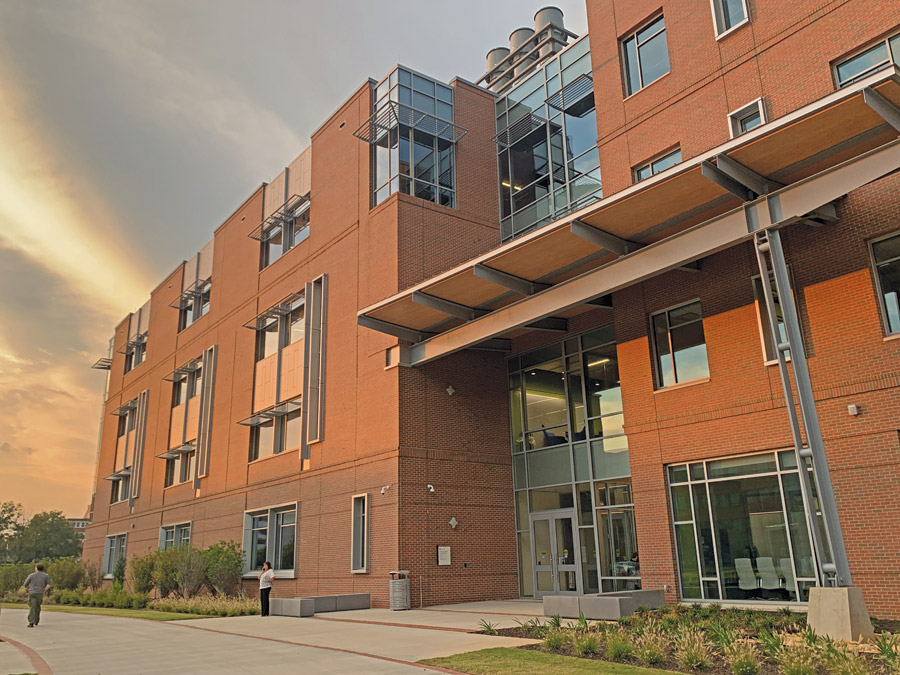
Gilbane Building Co. led construction of the recently completed $70-million College of Science and Math at Augusta University.
Image courtesy of the University System of Georgia
Changes and challenges
As with most other higher education owners, USG is attuned to the growing challenges of ensuring maximum value for the state’s investment in facilities in the face of rising costs and changing demographics. Neuse says the agency’s multiyear capital planning process is closely aligned with other trends happening throughout the system.
“We continually improve our facilities inventory data and improve planning for facilities and academic needs so we can be there with the facilities that are needed at the right time,” she says.
That mission also includes the growing awareness and application of sustainable planning, design and construction practices, an effort perhaps best exemplified by Georgia Tech’s Kendeda Building for Innovative Sustainable Design, which fulfilled the rigorous certification standards of the Living Building Challenge.
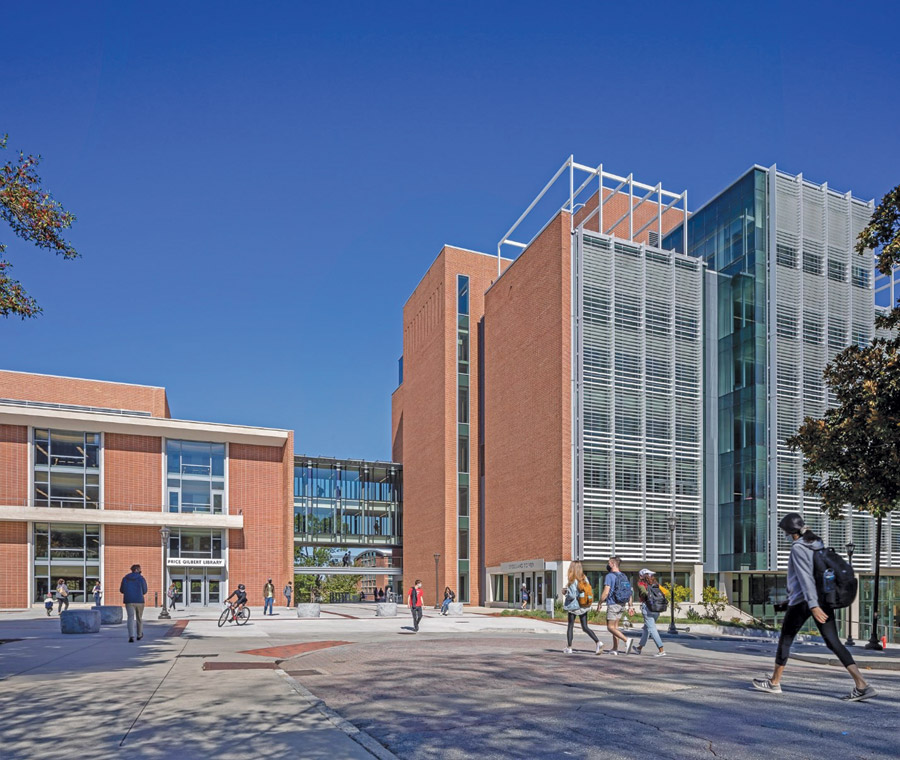
At the Georgia Institute of Technology, Brasfield & Gorrie led construction of the recently completed Price Gilbert/Crosland Tower Renewal project.
Image courtesy of the University System of Georgia
Neuse adds that institutions are also encouraged to voluntarily meet the Georgia Peach Green Building Rating System, which recognizes buildings that optimize energy performance and reduce demand on water supplies, increase the demand for Georgia-produced materials and furnishings and safeguard natural resources.
USG has also increasingly prioritized renovation of existing facilities over new construction.
“Being able to take an existing facility and give it new life, to me, is the ultimate in sustainability,” Neuse adds.
Shelly Attila, principal for May Architecture, Atlanta, says USG’s sustainability efforts have been enhanced by the agency’s priority in creating adaptable and flexible spaces.
“By looking at campuses and breaking down each building’s utilization, they have discovered space where others thought there was none,” says May, whose firm has worked on USG projects for more than a decade. “This trend towards flexibility has naturally enabled the integration of USG’s support for active learning within once rigid classrooms.”
In addition, Attila says USG has focused on ensuring accessible and equitable buildings, even with its most historic structures. “They look at how individuals approach and navigate the building and also their comfort within it,” she says.
Neuse is now exploring pandemic-related changes in building form and function, noting that the past few years have produced “all sorts of interesting twists and spins” that have served to highlight the role facilities play in the college experience, particularly the importance of in-person learning.
“When the students were away and learning online, they missed the experience being on a physical campus provides,” she says.
At the same time, USG is looking more critically at circulation and space needs as well as ways to incorporate redundant HVAC systems and other building infrastructure to ensure reliability and easy maintenance.
“What’s important is that the project supports each school’s education mission.”
—Sandra Neuse, Vice Chancellor for Real Estate and Facilities, USG
“We’re thinking of how facilities have had to adapt during the pandemic and where we can design and construct more flexible spaces that could be used for multiple purposes,” Neuse says. “One example is finding opportunities for hoteling spaces and open office concepts as opposed to dedicated office where it makes sense and doesn’t affect students’ ability to visit faculty during office hours.”
To help tackle those and other challenges, USG is counting on the ideas and innovation that comes from the collaboration of its design and construction teams.
“We want to make sure they’re engaging us at the right time, giving us options and recommendations on issues as they arise,” Pope says. “It’s something that we have been doing since we started using some of the alternative delivery methods, and we want to continue down that path.”
Neuse points to the last few years and “the interesting options” project teams have come up with to keep projects on schedules and navigate around supply issues. “They’ve really reinforced partnership and communication,” she says.
For these reasons and more, ENR Southeast recognizes the University System of Georgia as its 2022 Southeast Owner of the Year.



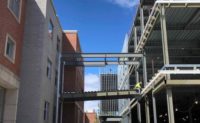
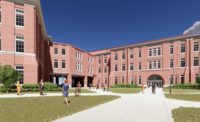
Post a comment to this article
Report Abusive Comment